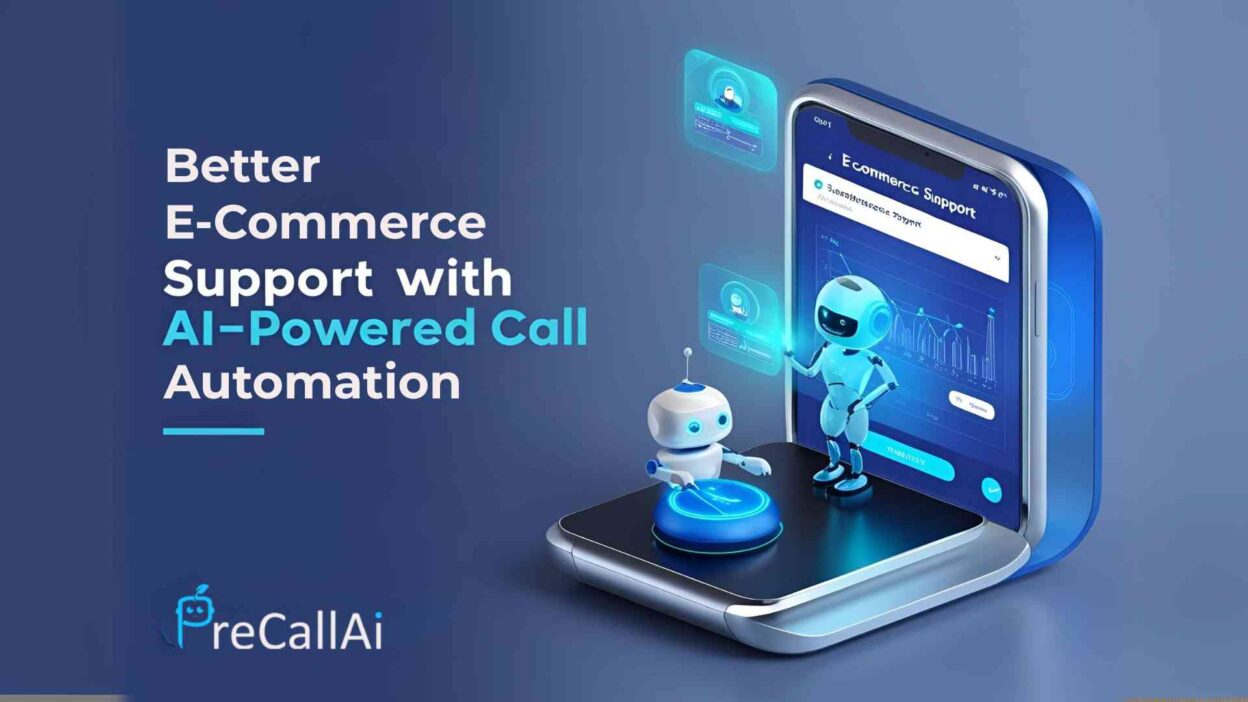AI-powered call automation transforms e-commerce customer support operations completely. Online businesses face increasing customer service demands daily. Traditional phone support systems cannot handle growing call volumes effectively. Customers expect instant responses and 24/7 availability consistently.
Table of Contents
E-commerce companies struggle with limited support staff during peak seasons. Holiday shopping periods overwhelm customer service teams regularly. International customers require support across different time zones. Manual phone handling creates bottlenecks and frustrated customers.
Modern shoppers demand immediate assistance with orders and products. Cart abandonment rates increase when support is unavailable. Customer satisfaction drops with long wait times. Lost sales result from inadequate customer service experiences.
Understanding E-Commerce Customer Support Challenges
Online retailers handle diverse customer inquiries throughout each day. Order status questions dominate customer service call volumes. Shipping delays generate numerous customer complaints regularly. Return processes confuse customers and require detailed explanations.
Product information requests demand accurate and detailed responses. Technical specifications need clear communication to customers. Compatibility questions require expert knowledge and quick answers. Size and fit inquiries influence purchase decisions significantly.
Payment issues create urgent customer service situations requiring immediate attention. Credit card processing problems frustrate customers during checkout. Refund requests need prompt processing and clear communication. Billing disputes require careful investigation and resolution.
Customer service representatives face repetitive questions consuming valuable time. Training new staff takes weeks and significant resources. Seasonal hiring creates temporary staffing challenges. Experienced agents leave for better opportunities frequently.
Common Support Bottlenecks
Peak shopping periods overwhelm traditional support systems completely. Black Friday and Cyber Monday create massive call spikes. Christmas shopping seasons strain customer service capabilities. Back-to-school periods generate high inquiry volumes.
International expansion complicates support operations across time zones. Language barriers create communication challenges with global customers. Cultural differences affect customer service expectations significantly. Local regulations impact return and refund policies.
Product launches generate intense customer interest and questions. New releases require extensive product knowledge training. Feature explanations demand detailed technical understanding. Early adopter questions challenge support team expertise.
How AI-Powered Call Automation Revolutionizes E-Commerce Support
Automated call systems handle customer inquiries instantly without delays. Natural language processing understands customer questions accurately. Speech recognition technology works with various accents and languages. Machine learning improves response quality through every interaction.
Order tracking becomes completely automated through voice commands. Customers receive real-time shipping updates without human intervention. Delivery estimates adjust automatically based on current logistics data. Package location information updates continuously throughout transit.
Return initiation happens seamlessly through automated phone conversations. Return policies get explained clearly and consistently. Shipping labels generate automatically during return requests. Refund processing begins immediately after return authorization.
Product recommendations occur during support calls based on purchase history. Cross-selling opportunities emerge through intelligent conversation analysis. Upselling suggestions align with customer preferences and needs. Personalized offers increase average order values significantly.
Integration Benefits for E-Commerce Platforms
AI-powered call automation integrates seamlessly with existing e-commerce systems. Inventory levels update automatically during product inquiries. Customer data synchronizes across all communication channels. Order modifications happen in real-time through voice commands.
Shopping cart recovery improves through proactive automated outreach calls. Abandoned cart reminders reach customers at optimal timing. Personalized offers encourage completion of incomplete purchases. Follow-up calls address specific abandonment reasons effectively.
Customer feedback collection becomes automated and systematic. Post-purchase satisfaction surveys conduct automatically via phone calls. Product reviews get solicited through conversational interactions. Quality metrics improve through consistent feedback gathering.
Specific E-Commerce Use Cases
Fashion retailers benefit from automated size and fit consultations. Style recommendations happen based on previous purchases. Color matching assistance occurs through detailed product descriptions. Care instruction explanations ensure customer satisfaction.
Electronics stores provide technical support through automated systems. Compatibility checking happens instantly during customer calls. Installation guidance gets delivered clearly through voice instructions. Warranty information explains automatically based on product registration.
Home goods retailers handle complex product assembly questions effectively. Room measurement calculations occur during automated conversations. Style coordination advice helps customers make confident decisions. Maintenance instructions get delivered clearly and comprehensively.
Beauty brands offer personalized product recommendations through voice interactions. Skin type assessments happen through guided questioning. Color matching occurs based on customer descriptions. Application techniques get explained clearly through audio instructions.
Customer Experience Improvements
Response times decrease from minutes to seconds consistently. Customers receive immediate attention regardless of call volume. Wait times become eliminated completely through instant connections. Service availability extends to 24/7 without staffing increases.
Consistency improves across all customer interactions significantly. Every customer receives identical high-quality service experiences. Product information remains accurate and up-to-date always. Policy explanations stay consistent regardless of timing.
Personalization increases through integrated customer data analysis. Purchase history influences conversation flow and recommendations. Preference tracking enables customized service experiences. Loyalty status affects service level and special offers.
Implementation Strategies for E-Commerce Businesses
Gradual rollout strategies ensure smooth transition from manual systems. High-volume inquiry types get automated first for maximum impact. Complex issues continue routing to human agents initially. Success metrics guide expansion to additional use cases.
Staff training focuses on managing automated systems effectively. Human agents handle escalated complex customer issues. Quality monitoring ensures automated responses meet standards. Continuous improvement happens through performance analysis.
Customer communication explains new automated support options clearly. Benefits get highlighted to encourage customer adoption. Feedback channels allow customers to suggest improvements. Change management ensures positive customer reception.
Measuring Success and ROI
Call volume metrics demonstrate capacity improvements clearly. Response time measurements show significant service enhancements. Customer satisfaction scores indicate service quality improvements. First-call resolution rates increase through automated accuracy.
Cost savings calculations compare staffing expenses with automation investments. Revenue attribution shows direct business impact from improved support. Customer retention rates improve through better service experiences. Lifetime value increases through enhanced customer satisfaction.
Operational efficiency gains free human resources for strategic initiatives. Agent productivity improves by focusing on complex issues. Training costs decrease through reduced manual support requirements. Scalability improves without proportional staffing increases.
Future of E-Commerce Customer Support
Voice commerce integration creates seamless shopping experiences. Customers place orders directly through automated phone conversations. Reorder processes happen through simple voice commands. Subscription management occurs entirely through voice interactions.
Predictive support anticipates customer needs before they call. Purchase patterns trigger proactive customer outreach. Shipping delays prompt automatic customer notifications. Product recalls initiate immediate customer communications.
Omnichannel integration connects voice support with all customer touchpoints. Chat conversations continue seamlessly through phone calls. Email inquiries get resolved through automated voice responses. Social media complaints receive immediate phone follow-up.
Read More: Voice Bot White-Label Solution: Offer Phone Automation
Conclusion

AI-powered call automation offers immediate benefits for e-commerce businesses. Implementation timelines range from weeks to months depending on complexity. ROI typically appears within the first quarter after deployment. Customer satisfaction improvements begin immediately after launch.
Technology partners provide comprehensive setup and training support. Integration specialists ensure seamless connection with existing systems. Ongoing optimization maintains peak performance levels. Scalability options accommodate business growth requirements.
Transform your e-commerce customer support with automated call technology. Experience the power of instant customer service delivery. Contact automation specialists to explore implementation options. Start improving customer experiences and reducing operational costs today.






[…] firm, and before AI, he was dealing with 2-3 scheduling conflicts every week. That meant awkward phone calls and unhappy clients. Now? Zero conflicts in six […]